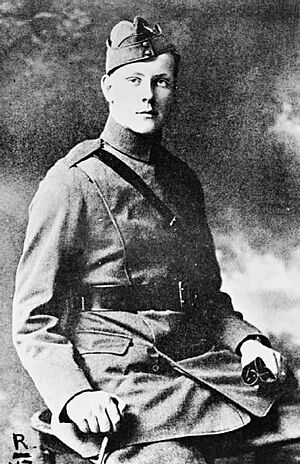Alan Arnett McLeod facts for kids
Quick facts for kids
Alan Arnett McLeod
|
|
|---|---|
 |
|
| Born | 20 April 1899 Stonewall, Manitoba, Canada |
| Died | 6 November 1918 (aged 19) Winnipeg, Manitoba, Canada |
| Buried |
Winnipeg (Old Kildonan) Presbyterian Cemetery
|
| Allegiance | Canada United Kingdom |
| Service/ |
Canadian Army (1913–14) British Army (1917–18) Royal Air Force (1918) |
| Years of service | 1913–1914 1917–1918 |
| Rank | Lieutenant |
| Unit | No. 51 Squadron RFC No. 2 Squadron RFC |
| Battles/wars | First World War |
| Awards | Victoria Cross |
Alan Arnett McLeod (born April 20, 1899 – died November 6, 1918) was a brave Canadian soldier and pilot. He received the Victoria Cross, which is the highest award for courage in battle for British and Commonwealth soldiers. McLeod flew planes for the Royal Flying Corps and later the Royal Air Force during World War I.
Contents
Alan McLeod's Early Life
Alan McLeod grew up in Stonewall, Manitoba, Canada. His father was a doctor. When he was only 14, Alan joined a military group called The 34th Fort Garry Horse.
When World War I started in 1914, Alan was sent home because he was too young. He tried many times to join the army in Winnipeg. He also tried to join the pilot training program of the Royal Flying Corps (RFC) in Toronto.
Becoming a Pilot
When Alan turned 18, he was finally able to join the RFC. He trained to be a pilot near Toronto. He learned very quickly, flying alone after just 3 hours of practice. He finished his training with 50 hours of flying experience. On August 20, 1917, he was sent overseas to France to join the war.
Alan McLeod's Service in World War I
At first, McLeod was sent to No. 82 Squadron RFC. But his commander found out he was only 18. So, McLeod was moved to No. 51 Squadron RFC to fly night missions for home defense.
Later, McLeod joined No. 2 Squadron RFC. This squadron worked near Hesdigneul in northern France. He flew his first mission in December 1917. With his gunner, Lieutenant Comber, he shot down an enemy plane in January. On January 14, he set fire to an observation balloon near Beauvin. He was praised for these brave actions.
The Victoria Cross Story
Alan McLeod was an 18-year-old pilot in No. 2 Squadron. On March 27, 1918, a very brave event happened near Albert, France. This is why he received the Victoria Cross.
McLeod and his observer, Lieutenant Arthur Hammond, were flying an Armstrong Whitworth F.K.8 plane. They shot down an enemy triplane. Right after, eight more enemy planes attacked them. McLeod and Hammond managed to shoot down three of these planes.
A Fiery Escape
During the fight, both McLeod and Hammond were shot and wounded. Their plane's fuel tank was hit, and the plane caught fire. McLeod quickly pushed the plane into a very steep side-slip. This helped to keep the flames away from them.
But the fire was still burning him. So, he bravely climbed out of his cockpit onto the left wing of the plane. He crouched low and held the joystick with his right hand. He then made a hole in the plane's fabric. This allowed him to reach the rudder-wire with his left hand. This way, he could still steer the burning plane.
He kept the flames away from his wounded observer, Lieutenant Hammond. He also stopped the plane from burning up completely.
Rescue Under Fire
The plane finally crashed in an area called No Man's Land. This was a dangerous area between the two armies. Even though he was badly hurt, McLeod didn't think about himself. He pulled his injured friend from the burning plane.
Under heavy enemy fire, he carried Hammond to a safer place. After this incredible effort, McLeod collapsed. He was exhausted and had lost a lot of blood.
An experienced German pilot, Leutnant Hans Kirschstein, was given credit for shooting down McLeod's plane. McLeod was shot three times in his side. Hammond was shot six times and lost a leg. Hammond also received a special award for his bravery.
McLeod was first suggested for a different award, but he received the Victoria Cross instead. He returned to Canada to recover from his injuries. Sadly, he died shortly after from the Spanish flu epidemic. He was only 19 years old, just five months shy of his 20th birthday.
Tributes to Alan McLeod
After Alan McLeod's death, many people honored him. Dr. David Christie wrote a touching tribute in a newspaper. He said that Alan McLeod was a true hero, like a knight from old stories. He believed that brave young people like Alan saved civilization.
Remembering a Hero
Today, there is a street in Stonewall, Manitoba, named after Alan McLeod. His old family home is now a tea house. Stonewall Collegiate, a high school, has a statue of him in its library.
In 1974, Alan Arnett McLeod was added to the Canadian Aviation Hall of Fame. This is a special honor for people who have done great things in Canadian aviation.
A group for young people, Number 301 (Alan McLeod V.C.) Squadron, Royal Canadian Air Cadets, was started in Stonewall in 2009. Also, a building at the 3 Canadian Forces Flying Training School is named the Lt Alan McLeod Building.
On May 9, 2017, a special stone marker and bronze plaque were placed at McLeod's grave. This was done by the Commonwealth War Graves Commission. Alan McLeod is the only Victoria Cross winner who died while still serving to be buried in Canada.
Images for kids




